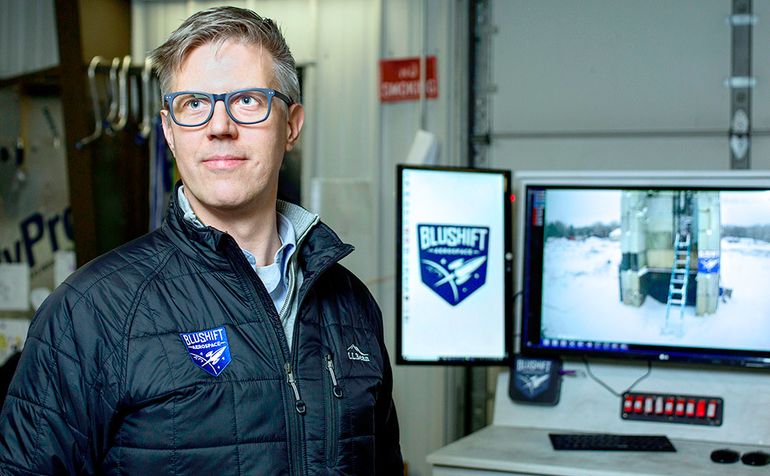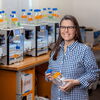Manufacturing's next frontier? Makers of small launch vehicles target booming nanosatellite market
Two startup manufacturers of small satellite launch vehicles have their sights set on a nanosatellite market that's literally taking off around the world.
And the companies' founders and industry experts say Maine is ideally positioned to develop a share of that market.
VALT Enterprises in Sanford and bluShift Aerospace, at Brunswick Landing, are developing small, low-cost launch vehicles to carry nanosatellites to orbital space. They seek to leverage a growing interest in the use of the small, lightweight, inexpensive satellites to conduct a broad range of applications.
Both aim to keep manufacturing and launch operations in Maine as part of a larger vision to foster a Maine-based nanosatellite sector.
“My dream is there's not only a Cape Canaveral of the future, but a Cape Cutler in Washington County,” says Sascha Deri, founder of bluShift.
VALT co-founders Karl Hoose and Elise McGill have conducted 22 test launches in the past decade from Downeast blueberry fields, chosen for their distance from large populations. They said they're ready to start flying their VALT suborbital systems, "where we step up speed and scale in subsequent flight tests to reach orbital capability at the end of three years."
Nanosatellites, Hoose says, represent a unique opportunity in space flight.
“The nanosatellite industry started small but has grown pretty big,” he says. “Maine needs to be part of that.”
An inexpensive vehicle
Nanosatellites are small satellites weighing up to a couple dozen pounds. Inexpensive to make, they carry electronics and sensors for a broad range of applications, primarily earth observation and communications. Nanosatellites add another tool for businesses and researchers, alongside GPS, drones and satellite images.
Over 6,200 nanosatellites are expected to launch over the coming decade, according to Euroconsult.
As a result, an industry to build small launch vehicles is also growing. To date, small satellites are carried into space on rideshare arrangements as secondary payloads on large rockets. Nanosatellite operators don't have a say over schedules or routes.
“It's essentially like a bus and everyone on the bus is going to the same place,” says Hoose.
A growing segment of companies, including powerhouses like Richard Branson's Virgin Orbit, is developing small launch vehicles to serve, essentially, as taxis, allowing nanosatellite operators to choose the time and orbital configuration for deployment.
Enter VALT and bluShift.
bluShift Aerospace
Deri, with a team of seven engineers, is developing a line of eco-friendly rockets, using a new type of bio-derived fuel, to provide affordable launch services. BluShift is targeting universities, corporations and federal agencies that want to launch nanosatellites into altitudes of 400 miles or less. There's already a year-long backlog of organizations seeking to launch nanosatellites, he says.
Raised in Maine and holding degrees in physics and electrical engineering, in 1999 Deri founded AltE, a Boxborough, Mass.-based solar company that he still runs. He started bluShift in 2014, working at TechPlace and leveraging its machine shop, tools and composite layup areas to accelerate R&D without enormous upfront capital. His original aim was to build a small suborbital rocket prototype to carry a payload of 10 kilograms, or 22 pounds.
With test launches planned through late next year, the next goal is to test a full-sized launch vehicle. The latter will carry 50 kilograms, or 110 pounds, and accommodate 20 to 30 nanosatellites. Manufacturing of the larger vehicle is expected to begin in early 2021, for commercial launch in 2022. The larger vehicle will be about the length of a telephone pole, he says.
Construction of the smaller vehicle will cost less than $100,000, but the larger vehicle could cost upwards to $800,000. Deri says he expects construction costs to decrease as the business scales up.
The project has been financed by $250,000 of investment from his solar company and personal funds, sweat equity from his volunteer team of engineers and designers in return for company ownership and $50,000 in Maine Technology Institute grants and in-kind services. He's seeking further grants from MTI and NASA's Small Business Innovation Research program and angel investment. It is also crowdfunding through Patreon (check out the video on patreon.com/blushift). Funds will help hire a full-time mechanical engineer from the volunteer pool and pay for machining-and-fabrication space and new infrastructure near the test site. He's avoiding venture capital funding to retain control of the company.
“When venture capitalists get involved, the passion and technology often get lost,” he says. “I don't want to that happen in Maine.”
He expects to complete small-engine testing, costing $150 per five seconds of fuel use, this spring. Large-engine tests cost $750 a pop.
“That's the type of thing crowdfunding can help us punch through,” he says.
Once the larger rocket rolls out, payload space is tentatively priced at less than $25,000 per kilogram, he says. The plan calls for seven launches the first year, and monthly to weekly launches by the second year, when he says payback on investment will begin.
Working with nanosatellite launch brokers, he has developed an initial customer base, including institutions that want to test communications technology in space conditions.
VALT Enterprises
In Sanford, Hoose and McGill are developing a 20-foot launch vehicle. It incorporates a hypersonic “airbreathing” propulsion system, which lightens the rocket's weight and increases cargo space by eliminating the need to carry oxidizer tanks for its fuel mix, instead drawing oxygen from earth's atmosphere. The eastern Maine coast and Loring Commerce Centre have been identified as options for potential launch sites.
The initial ticket price for a 55-pound payload is expected to be $1.75 million. He says that will decline as business scales up.
“We expect it to be a lucrative business,” he says.
In 1989, Hoose founded Applied Thermal Sciences, a specialty engineering firm in Sanford with 30,000 square feet of facilities, 30 employees and, at its peak, $10 million in revenue. The recession shut down much of its government business, he says, and the company closed in 2015.
One piece of that, rocket research funded by a 2009 grant of $750,000 from the Office of Naval Research, helped with the development of VALT.
“We found there were people who needed access to space, at specific places and times,” Hoose says.
Hoose invested $4 million from Applied Sciences and personal sources. He expects to raise another $30 million in the next three years. Some revenue will come from government and possibly commercial clients paying for space access during VALT's suborbital tests. VALT is also pursuing crowdfunding and grants.
Hoose says he's confident he'll raise the money, given his prior industry knowledge and relationships. Funding will pay for a manufacturing facility, initially 5,000 square feet, and an initial 10 engineers and business people. In-house manufacturing will keep the project on schedule and minimize costs, he says.
McGill says there's strong correlation between current and emerging commercial, civil and government applications and missions and nanosatellites.
“One of VALT's primary goals is to support the emergence of a huge wave of new space entrepreneurs, here in Maine first, and then across the U.S. and abroad,” McGill says.
Aerospace outlook
Challenges include uncertainty around the overall nanosatellite market, still in its infancy. There's also concern about the potential for small satellites to worsen the issue of orbital space debris. Manufacturing challenges include optimizing payload-to-vehicle-weight ratios: a payload that's too heavy will prevent the vehicle from achieving propulsion needed to reach orbit.
In Maine, VALT and bluShift's developments occur against a couple of backdrops.
One is Maine's existing supply chain that services the aerospace industry.
The Maine Aerospace Alliance, which was formed in 2010, grew out of efforts by the Maine Technology Institute to attract aerospace work to Maine, says Manufacturers Association of Maine Executive Director Lisa Martin.
It had been led by Rich Grich, who helped develop the University of Maine's aerospace engineering program but passed away in January 2018. He helped the alliance build its membership to 45 to 50 companies.
Producing parts and components related to aerospace, companies are poised for development of a nanosatellite sector, Martin says.
Terry Shehata, director of the nonprofit Maine Space Grant Consortium, agrees. He initiated an ambitious plan to develop a spaceport called the Maine Space Entrepreneur and Innovation Complex for students, educators and researchers.
Shehata says Maine's advantages for a nanosatellite sector include an existing aerospace industry, as well as infrastructure and location: Maine's coastline provides direct access to “polar orbits,” the equivalent of prime real estate for space researchers.
The spaceport would be a public-private partnership that would include companies that already have sites in Maine, including Texas Instruments, Bath Iron Works, Pratt & Whitney and ON Semiconductor. It would attract additional research and development companies, startups, manufacturers, data analysis professionals, launch providers and suppliers to Maine, Shehata predicts.
Unlike other complexes around the country, which are focused on launch facilities, Maine's would include research and commercialization opportunities and education and workforce training, he says.
The consortium is conducting a market study on the idea. Funded by grants from the Maine Technology Institute and NASA, it's expected out this summer.
“We have to make sure there are users and clients out there on a national scale willing to invest in a spaceport in Maine,” says Shehata.
The concept could inject new energy into Maine's aerospace sector, Martin says.
“Ten years ago, really nobody was talking aerospace in the state of Maine,” Martin says. “People said, 'Maine? Aerospace?' Now, we have pretty substantial interest.”
















Comments